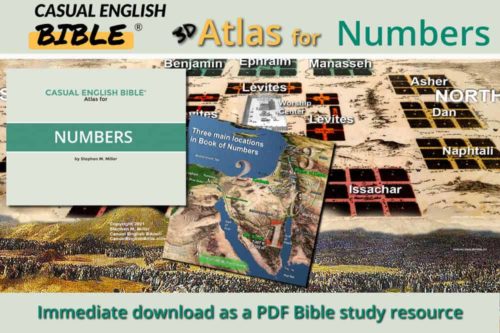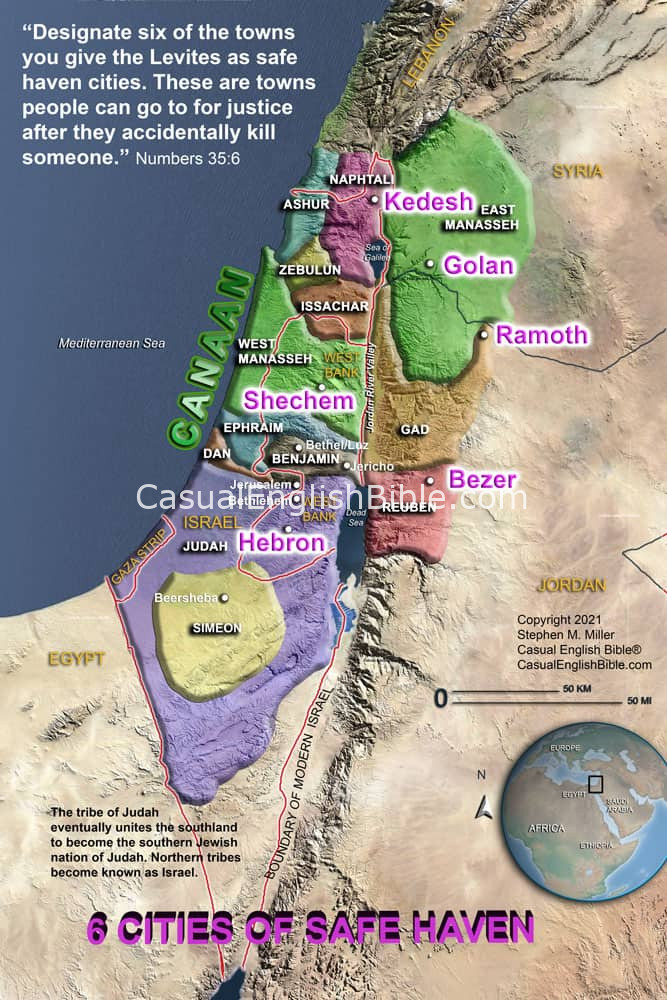Numbers 35
Make room for priest families
Levites, the city folks
1Israelites were still camped in the Moab plains, near the Jordan River, across from Jericho, when the LORD spoke to Moses:2Order the people of Israel to give Levi’s tribe some of their cities, along with grazing pastures outside the cities. 3These towns will belong to the Levites. Levites will live in the cities. And they will graze their livestock in the nearby fields. 4Give the Levites pasture extending 500 yards [1] outside the city walls. 5Measure 1,000 yards [2] in all four directions outside the city. That will become each city’s pastureland.
Six cities of safe haven
6I want you to designate six of the towns you give the Levites as safe haven cities. These are towns people can go to for justice after they accidentally kill someone. You should give the Levites 42 cities in addition to the six safe haven cities. 7In all, you should give the Levites 48 cities and the pastures around them. 8Take more of these cities from the larger tribes and fewer from the smaller tribes. Every tribe will contribute. [3]9The LORD also said to Moses: 10Tell this to the people of Israel:
Cross the Jordan River and go into the land of Canaan. 11Once you get there, select the cities of safe haven. These are towns where people can find immediate safety after they accidentally kill someone. 12Family and friends of the dead are not allowed to avenge the dead in these cities. It’s illegal for them to go into these cities and kill anyone accused of causing the death. The town should protect the accused and give that person a fair trial.
13So, make sure you designate six towns as safe havens. 14Split the six cities in half, designating three on each side of the Jordan River. Find three safe havens in Canaan. And find three east of the river. [4] 15These safe haven cities aren’t for Israelites alone. They’re for everyone. That includes immigrants living among you and strangers new to the land. Anyone who accidentally kills someone can find protection in these cities.
When they’re guilty
16If the accused hit and killed someone with an iron object, that’s murder. You’ll need to execute the killer. 17If the accused hit and killed someone with a rock, that’s murder. The killer has to die. 18If the accused hit and killed someone with a wooden object, that’s murder. Execute the killer.19A family member with blood ties to the victim should perform the execution. That’s the person who should do it. 20So it’s like this. Someone might hate another person enough to throw something at that person, hoping to kill the person. Or someone might angrily push another person, hoping that person will fall and die. 21Also, someone might hit someone—on purpose—hard enough to kill that person. In cases like these, a relative of the victim needs to execute the killer.
When they’re innocent
22But it’s different if the push wasn’t hostile. It makes a difference, too, if an object wasn’t thrown in anger. 23Also, a heavy object might accidentally fall on someone and kill that person. The other person might not have been an enemy and might not have wanted the victim to die. 24If the death looks accidental, the local community has to make the judgement call. Those people have to decide between the accused and the family who wants to avenge the victim.25If the death was accidental, the city has to protect the killer from the avenging family. Make room for that person to live in the city of safe haven. The killer has to live there until the anointed high priest dies. [5]
26If the killer goes outside the city, 27and if someone in the family kills that person outside the city, it’s not murder. 28The killer made the fatal mistake of leaving the security of the designated city. The killer should have stayed there until the high priest died. After that, the killer would have been free to go home.
29These are the laws you’re to obey from now on, wherever you live. 30Execute all murderers. But don’t do it on the word of just one witness. You need at least two witnesses. 31Don’t let someone get away with murder by paying a fine. There’s no amount of money they can pay to escape execution. The murderer has to die. 32And don’t let a killer living in a safe haven city pay to go home before the high priest dies.
33These laws protect the land from pollution. Murder pollutes the land. Nothing but the blood of a murderer can cleanse a land polluted by murder. 34This land is your land. But this land is my land. I am the LORD and I live here among you. So don’t pollute.
Footnotes
That’s 460 meters. The Hebrew measurement is 1,000 cubits.
That’s 920 meters. It’s double the size of the pastureland in 35:4. So which is it? Do Levites get a square around the city of 500 yards on each side or of 1,000 yards or maybe 1,500 yards. Also, in the hills where the Bible says most of the first Israelites settled, the useful pastureland was sometimes much further away than a few hundred yards or meters. Some scholars have offered theories that try to make sense of the different sets of measurements. But most scholars don’t seem to warm up to any of the ideas. They treat the apparent contradiction as a mystery or a mistake.
They get 48 towns scattered among the tribes, according to Joshua 21. Nine tribes give them four cities each. Judah gives them eight cities. Naphtali gives them three. Simeon gives them one. Surprisingly, the tribe of Simeon didn’t seem to give its fair share of cities. In the census of Numbers 1, Simeon was the third largest tribe. Judah was biggest, and Naphtali was in the middle of the pack, number 6 of 12. By population, the tribes are Judah, Dan, Simeon, Zebulun, Issachar, Naphtali, Gad, Reuben, Asher, Ephraim, Benjamin, and Manasseh.
The six cities will be Kedesh in Galilee, Shechem in the central hills, and Hebron (Kiriath-arba) in the southland—all in Canaan. East of the Jordan River: Bezer, Ramoth, and Golan (Joshua 20).
Scholars have to guess what the death of the high priest has to do with how long an accidental killer had to live protected in a city of safe haven. One guess: the death of the priest atoned for the accidental death. Though the killer was judged innocent, a person died. And the killer bears some responsibility for that—some guilt that needs paid for and forgiven. Living in the confines of the city of safe haven, perhaps far from family, may have been part of the price the killer had to pay. But the final atonement was the death of the priest—the blood of the priest, atoning for the blood of the victim. One person died, though accidentally. Another had to die to pay for it. Only then would the killer be back on good terms with God. That’s one interpretation.
Discussion Questions
- Sorry, there are currently no questions for this chapter.






